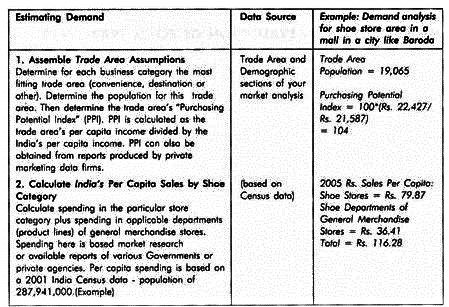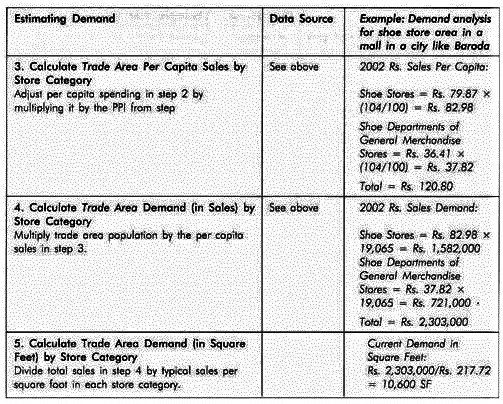Evaluation of Retail Trade Area
To begin the evaluation of retail opportunities, the market analysis study should be done to understand demand and supply of major categories to determine market potential. Demand refers to the amount of retail space (in square feet) that could be supported by consumers residing in the trade area, based on estimates of their spending potential.
Supply refers to the actual square feet of retail space, sometimes called Gross Leasable Area (GLA), that currently exists in the trade area. A comparison of demand and supply by store type can help identify gaps (demand exceeds supply).
After considering other more qualitative market factors including how and where local residents/people shop, conclusions can be drawn regarding potential business categories worthy of business expansion or recruitment efforts.
A flowchart describing this method is presented below:
Estimating Retail Demand:



Estimating Retail Supply
To analyze supply, a database of existing businesses needs to be constructed for each of the store categories under investigation. The database for each store category should include all of the retail businesses within the trade area used to calculate demand. The database should include a list of the names and addresses of all the current retailers in the primary trade area.
For each retail store, include a reasonable estimate of store size in square feet. For general merchandise stores, include the approximate number of square feet devoted to that product line. While calculations of retail space in a market area are often based on observation and rough estimates, they do provide a reasonable and important “ballpark” figure for this analysis.
Square feet of store space is often called gross leasable area (GLA). It can be estimated by actual measurement of a building’s street-front width and estimate of its depth.

Other Market Considerations
Examining quantitative aspects of demand and supply is only part of the analysis. There are also a number of qualitative considerations that require local knowledge and insight about the market. The previously calculated differences in retail space demand and supply need to be analyzed in context of other market factors.
The following provide additional considerations that add to the analysis of each category.
-
Survey and Focus Group Findings
What have we learned from local research about consumer behaviour and perceptions of the downtown? We must use findings from “Study of Consumer Attitudes”.
-
Trade Area Demographic and Lifestyle Findings
Does lifestyle segmentation data indicate that local residents are more likely to purchase goods within this store category? Use findings from “Study Customer Demographics and Lifestyles”.
-
Analysis of Non-Local Market Segments
Is there significant market potential from non-resident customer segments such as tourists and commuters?
-
Retail Mix Analysis
How many businesses in the category are located in the downtown areas of comparison communities?
-
Competitiveness of Existing Stores in Trade Area
Are existing stores/markets/malls in this category providing the merchandise and service local shoppers demand?
-
Competitiveness of Existing Stores Outside of the Trade Area
Do surrounding communities with regional shopping centers and big box stores siphon business in this category out of the trade area?
-
Consumer Behaviour and Trends in Store Category
Are purchases driven by convenience or comparison-shopping? Do stores of this type locate in downtown districts anymore?
-
Drawing Conclusions
The quantitative comparison or retail space demand and supply by store type provide an initial measure of market opportunities (i.e. demand greater than supply). However, demand and supply must be analyzed in combination with many other market considerations.
If there appears to be a significant amount of unmet demand, there may be opportunity for an existing business to expand or a new business to be recruited. Business development opportunities may also exist in areas where supply is greater than demand, especially in those communities that are successful in drawing customers from outside their trade area because of a special product niche they have created.
Analyzing Trade Area
A trade area is simply the geographic area that generates the majority of the customers for a community, business district or downtown. Knowing the boundaries of the trade area defines the number of potential customers that may patronage your downtown.
Furthermore, knowing the trade area allows for demographic and lifestyle information to be gathered from a variety of public and private sources. This information provides insight into the people in the trade area and eventually will allow consumer demand for products and services to be calculated.
Therefore, defining the trade area is an important step in market analysis. A trade area often extends beyond the municipal boundaries of a community. Defining this extent is important, but it is also necessary to recognize how a trade area can vary.
In other words, a downtown may have a number of different trade areas depending on a variety of factors. Often, the variability can be attributed to either different types of products and businesses, or different market segments of customers.
How Trade Areas Differ?
Different business types will have different trade areas, that is, people will travel from greater distances to purchase certain goods and services than others. While each individual store may have its own unique trade area, these areas can often be generalized into two different types: convenience shopping trade areas and comparison shopping trade areas.
Local convenience trade areas are based on the ease of access to these types of products. That is, people will obtain these products (apparel, groceries, etc.) based on travel distances or travel time.
Conversely, comparison shopping trade areas are based on price, selection, quality and style. People are more likely to compare these types of goods (appliances, furniture, etc.) as well as travel longer distances for their purchase. Subsequently, the trade area will shrink or grow depending on the products sold. In addition to different types of shopping goods, there are also different types, or market segments, of customers frequenting a downtown.
Three common market segments are local residents, daytime employees and tourists. Local residents live within the trade area. As they reside year-round, they provide the majority of spending potential for most downtowns. Daytime employees may live in the trade area, but may also commute from other outside areas.
However, while these employees are in the downtown, they provide the potential to stay and make purchases. Furthermore, depending on the community, tourists can provide a large amount of spending potential. While they are not permanent customers, tourists make purchases while they visit the area.
Simple Methods of Trade Area Definition:
Even though trade areas vary by store type and market segment, one or possibly two general trade areas are needed to proceed with the market analysis. To define these trade areas, there are several techniques available. These techniques have different uses as well as their own advantages and disadvantages.
Each of these methods is described in detail below.
-
Reilly’s Law of Gravitation:
Reilly’s Law of Retail Gravitation is a theoretical means of trade area definition. It is based on the premise that that people are attracted to larger places to do their shopping, but the time and distance they must travel influence their willingness to shop in a given city.
In other words, people are more likely to travel shorter distances when possible. Additionally, customers are more likely to shop in larger communities, as they provide a greater opportunity for goods and services.
Reilly’s Law provides a mathematical formula that can be used to calculate hard numbers relating the distance people will travel. However, a simple map and commonsense can be combined to use the concepts behind Reilly’s Law and generate general trade area boundaries.
-
Pin code Tabulation:
Another simple method for trade area definition is to tabulate the number of customers by their pin codes. As later explained, pin code data can be collected using a variety of methods and sources.
However, regardless of how the data is obtained, there are a number of advantages to the pin code tabulation method:
- Collecting information from customers allows the trade area to be based on real business data, instead of created from a theoretical basis.
- Comparing the trade area maps of different businesses can identify opportunities to increase market size and penetration. For instance, the trade areas for businesses that primarily sell convenience items can be compared with each other to identify differences. These differences could indicate potential market expansion opportunities for some of the businesses. The same can be done for comparising shopping businesses.
iii. Trade areas for different market segments can be compared. Businesses serving residents can be compared to the origins of employees at a major employer. Furthermore, pin codes are ideal for tracking the origins of non-local tourists.
While tabulating customer zip codes has the ability to capture trade area variability, an appropriate sample of participating businesses must be incorporated. For instance, stores that serve both convenience and comparison shopping segments are necessary to understand the local market. Businesses that serve tourists are needed to examine the tourist market
One thought on “Market Area Analysis”